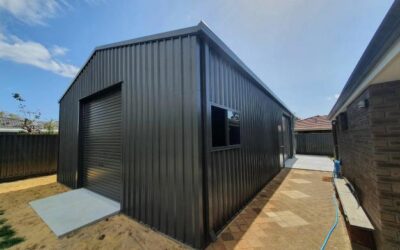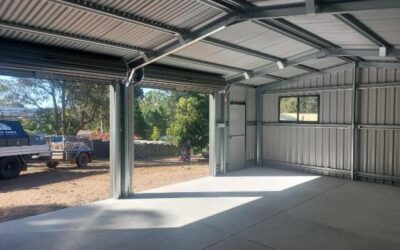How to Waterproof a Shed?
Why Waterproofing is a Must
Waterproofing isn’t just about stopping leaks; it’s about protecting your investment. A shed that’s not properly sealed will cost you in the long run, whether it’s replacing rusted tools, fixing structural damage, or dealing with endless repairs.
- Protect your gear: Moisture wrecks everything; tools rust, equipment fails, and anything made of wood or fabric starts to rot or grow mould.
- Keep your shed solid: Water weakens wood, corrodes metal, and can even compromise your shed’s foundation over time.
- Save yourself the hassle: Fixing leaks after they cause damage is always pricier (and more of a headache) than getting it right from the start.
- Make it last: A properly waterproofed shed stands the test of time, needing minimal upkeep while staying tough against the elements.
Start with the Right Build
The best way to waterproof a shed is to build it properly from the beginning. A cheap, lightweight shed from a hardware store will always be at risk of leaks, no matter how much sealant you slap on it.
- Choose the right materials: Steel is the way to go. Timber sheds might look nice, but they’re a maintenance nightmare, warping, cracking, and rotting over time. High-quality Australian Bluescope Colorbond or Zincalume steel will handle tough conditions without the hassle.
- Ensure a solid roofing system: If the roof isn’t up to scratch, you’ll be fighting leaks forever. That’s why we use genuine Colorbond steel in profiles like Corrugated or Trimdek roofs, paired with top-notch sealants and expert installation, as it keeps the water out and your gear dry, no matter what the weather throws at it.
- Build on a strong foundation: A shed without a properly sealed concrete slab is just asking for trouble. Moisture from the ground can rise through paving or a cheap concrete slab that lacks a plastic moisture barrier, leaving your shed damp and potentially damaging anything stored inside. To avoid this, invest in a quality concrete slab with the correct underlay; your shed (and everything in it) will thank you.
Professional Site Preparation
Even the best materials won’t hold up if your site isn’t prepared correctly. Water pooling around your shed will cause long-term damage, which is why proper drainage is crucial.
- Grade the site correctly so water drains away from the shed instead of pooling around it.
- Install additional drainage solutions like gravel trenches if you’re in a high-rainfall area.
- Raise the shed slightly above ground level to avoid flooding and water damage over time.
Waterproofing Your Shed
If your shed wasn’t built with waterproofing in mind, or you want extra protection, here’s what to do.
- Inspect and seal the roof: Look for cracked or loose panels and fix them fast. A quality roof sealant, bitumen or acrylic-based, adds an extra layer of defence. If the roof is already failing, replacing it with corrugated steel sheeting is the best long-term fix.
- Protect the walls: Seal up gaps and joints properly. Adding metal or vinyl cladding gives even more protection, and a weatherproof primer and topcoat keep moisture out.
- Secure the floors: If your floor isn’t waterproofed, you’re in for a world of pain. A fully sealed concrete base with a vapour barrier stops moisture from coming up, and a concrete sealer adds even more defence.
- Reinforce doors and windows: Weatherstripping around doors and windows keeps out the rain, while industrial-grade silicone seals up the frames properly. If you’re dealing with leakage coming through your roller doors, adding a threshold weatherstrip along the concrete can help block water from sneaking in under the roller door.
Extra Waterproofing Measures for Large Sheds
For rural and industrial sheds , extra waterproofing is a must.
- Install a proper gutter system: If water runs straight off the roof and pools at the base, you’re in trouble. Gutters and downpipes keep things dry.
- Improve stormwater drainage: If your area gets heavy rain, extra drainage is a smart move. No one wants to wade through a swamp to get to their shed.
- Enhance wind resistance: High winds drive rain into joints and gaps, so a cyclone-rated steel shed with reinforced sealing is the way to go in extreme weather zones.
Ongoing Maintenance for a Watertight Shed
Even a properly built shed needs a bit of upkeep. Stay on top of it, and you’ll avoid bigger problems down the track.
- Inspect for leaks every six months: Spot cracks, water stains, or damp spots before they get worse.
- Clean gutters and downpipes: Blocked gutters cause overflows, which means water where you don’t want it.
- Reapply weatherproof coatings: When needed. A fresh coat of sealant keeps your shed in top shape.
- Ensure proper ventilation: Good airflow stops condensation, which means no mould or mildew.
- Keep an eye on rust: If you’ve got a steel shed, check for corrosion and deal with it early.
Get a Shed Built to Last
A shed shouldn’t be something you have to constantly patch up. If you’re tired of leaks, damp gear, and endless maintenance, it’s time for a proper solution. Knowing how to waterproof a shed the right way is important, but the best solution is a shed that’s built to handle the elements from day one. At Spinifex Sheds, we build custom, heavy-duty steel sheds made for Australian conditions, built tough, with no shortcuts and no compromises.
With nearly 20 years of hands-on experience, our expert team knows what it takes to build a shed that actually lasts. From workshops to farm sheds, and industrial storage sheds to commercial structures, we handle the lot. We take care of site preparation, council approvals, and full construction, so you don’t have to waste time chasing up unreliable tradies or dealing with DIY fixes.
Want a shed that works as hard as you do? Get in touch today or use our online shed builder to design the perfect shed for your needs.
Similar Articles
Man Shed Ideas: Turn Your Shed Into a Personal Escape
A shed’s never just a box with a door. It’s where you stash the gear, sort your tools, or line up your next project. Whether you’re fixing the ute, catching the footy, or just want a spot to disappear for a bit, the right setup makes all the difference. Even if it’s just for storage, it should still be tough, weatherproof, and built to last.
How to Keep a Shed Cool in Summer
If you’ve spent a summer working out of a steel shed in the WA heat, you know how fast it can turn into a sweatbox. Whether you’re parking gear, storing feed or knocking out a few jobs in the shade, the last thing you want is to step into an oven every time you open the roller door
How to Build a Machinery Farm Shed (Properly)
Machinery is the backbone of any farm. Tractors, headers, sprayers, seeders. These are big investments that keep everything moving. Leaving them out in the weather or under a flimsy shed leads to rust, costly repairs, and downtime when you least need it.










